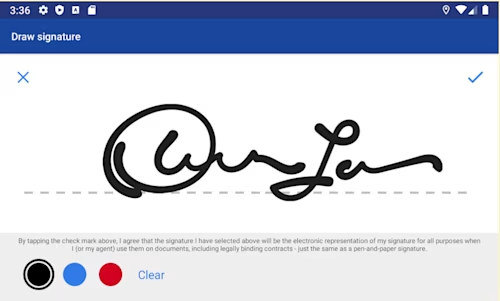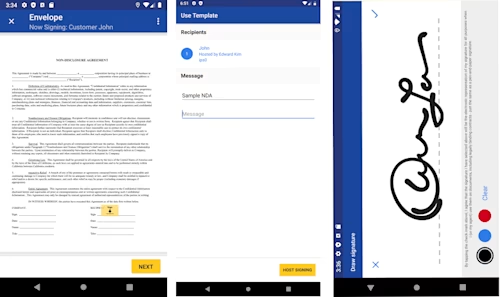
Docusign Android SDK available
Unlock eSignature technology in your own mobile app


Docusign is proud to announce the release of our new Mobile Android SDK. With this release, Android developers for the first time have direct support for their Docusign apps.
Why did we build this?
At Docusign, we are committed to helping our customers and developers be as productive as possible. We are continuously enhancing our products and making more features available. We listen to our customers and strive to alleviate their pain points and friction.
We have heard from a number of customers that they would like to use our eSignature technology when internet connectivity is spotty or even nonexistent. Enter offline signing! Offline signing works as the name suggests; it enables users to review and electronically sign while not connected to the internet.
Offline signing is the same technology available in the Docusign Android and iOS apps, available for free in Google Play or the AppStore. Using these apps, if internet connectivity is lost, the completed documents are securely synced with a Docusign datacenter when the connection is restored.
The Docusign Native iOS SDK is already available and is making life easier for developers of all stripes. However, if you want to incorporate custom functionality into your own Android app to leverage offline signing, we have just released a new Docusign Mobile Android SDK. Here are some example use cases perfectly suited for offline signing:
Field sales representatives that capture sales order details on the go
Contractors that work in remote locations
Service or health professionals collecting financial agreement in customers’ homes
Insurance agents filling out claims onsite
Retail kiosks or conference portals for sign up
Note: You must have a Business Pro or Enterprise Pro account to use offline signing.
So what exactly is in the Android SDK?
The Docusign Mobile Android SDK is a library that provides native signing UI components (see below for more information) that can be easily integrated into your Android apps. The SDK supports our very popular template-driven envelope creation workflows. Using this SDK, you can integrate the signing UI components into your app with just a few lines of code and avoid directly interfacing with the eSignature REST API.
The Android SDK is supplemented with complete documentation and examples using Java and Kotlin. Each demonstrates most aspects of integration and offline signing with the Docusign Mobile Android SDK.
What eSignature components can I leverage?
The Android SDK contains reusable UI components that make it easy to accept signatures using templates and sign envelopes through a single, unified integration. These prebuilt components drastically reduce the time needed to create beautiful, high-conversion Android signing flows. Some of these components, shown in the image below, include:
Adding Recipients: Preset Docusign templates make it easy to add a recipient’s details to envelopes sent from your app. The DSTemplateDelegate class exposes various methods to initiate the document signing workflow.
Offline Signing Ceremony: A template-based signing ceremony can be used to get signatures from users when there is no network connection. The DSTemplateDelegate class can be used to list, download, and use templates with a given Docusign account. After the template is selected and the signer’s information is provided, the SDK automatically moves into offline signing. The DSEnvelopeDelegate class provides an interface to query envelopes ready to be synced with Docusign.
Signature Pad: You can use the Signature pad to capture signatures and initials during the document signing workflow. Signed documents are stored securely until envelopes are synced with Docusign.

Repeatable workflows use templates
Templates are core to the Mobile SDKs. They help streamline the envelope-sending process when you frequently send the same or similar documents to one or more recipients. Templates enable you to create repeatable transactions easily and let you modify aspects of the envelope, such as recipients, documents, custom fields and workflow. In other words, templates save you time by enabling you to configure your workflow once and reuse that workflow in subsequent requests.
For example, suppose you have a standard NDA your customers may sign at any given time. A template is the perfect solution because you define the NDA template once and send it to recipients, substituting the recipient information at runtime. A template can include multiple documents and can be sent to one or more recipients, using a signing order (or not), and they can be shared across an entire Docusign account, or be made private per user.
How do I know when to use the Mobile Android SDK or eSignature REST API?
First and foremost, if you need to create a custom Android app that supports offline signing using template-driven workflows and your Docusign account permits this feature, the Mobile Android SDK is for you. No other Docusign developer tool enables this functionality. (The standard Docusign Android app does provide this functionality, but you can’t customize it.)
The following table illustrates the differences:
Feature | Mobile Android SDK | |
|---|---|---|
Core technology | Kotlin-based library with native Docusign signing UI components | Android developer access to Docusign eSignature API via Java language service layer |
Full eSignature REST API access | No, only template-driven document workflows | No; most API endpoints are covered, but no offline access or account management endpoints |
Native signing UI components | Yes | No, developers must build custom UI components to support API requests and responses |
Offline capabilities | Yes, offline signing driven by templates and envelope creation | No, online only |
Supports all Docusign tab types | No, supports signature, initials, name, date, textbox, checkbox, company, radio button and title tabs | Yes, all tab types are available and supported |
Xamarin Android support | Yes | No |
Additional resources
Related posts
Docusign IAM is the agreement platform your business needs




